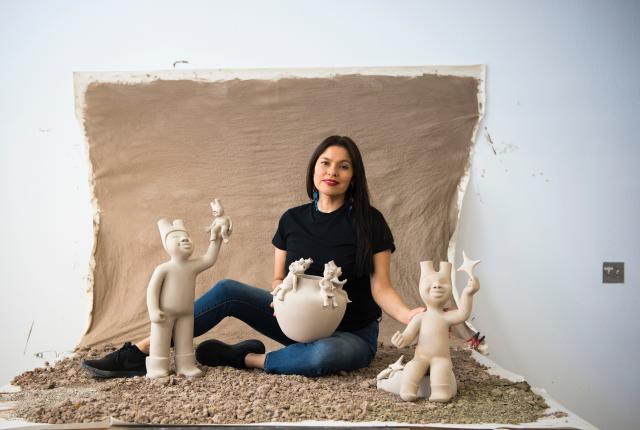Kathleen Wall uses pottery to tell stories and push boundaries. Photograph by Ungelbah Dávila-Shivers.
THROUGH CLAY, ARTIST KATHLEEN WALL USES the earth from which her ancestors emerged to document the stories of her Jemez Pueblo community and Indigenous people all across Turtle Island. Wall, whose mother is Jemez and father Chippewa, inherited pottery making from her mother and aunts, learning to make and market storyteller dolls at a young age. “I know my work really pushes the boundaries of Pueblo pottery,” she says, “but I feel as though that’s what I’m grounded in.” During a decades-long career, Wall has developed a whimsical style of figurative forms, such as her koshare (clowns), whose smiling faces reflect her joy as an artist. Wall’s various clay and mixed-media series playfully explore underlying themes of Indigenous life, including food sovereignty, religious freedom, and displacement. The Museum of Indian Arts and Culture, in Santa Fe, has named Wall as this year’s Native Treasures Living Treasure and features her work in a new exhibit, A Place in Clay, through May 2022.
My art is an evolution of Pueblo pottery.
I took that traditional knowledge and nurtured it over time, and it’s become a very expressive Pueblo clay collective. It’s turned into a multimedia type of work.
A lot of times my work is depicting the world around me, whether that’s Jemez or Navajo or the Plains—wherever my friends and family are from.
The whimsical koshare figures are my signature pieces. My faces come out with a joyful look—though it’s not always intentional.
I find Native people so inspiring. A lot of my work celebrates that.
In my younger years, I did a lot of wall hangings. When I was in college, they got me through, feeding me and paying my rent. They were my big move from the figurative storyteller work.
I’m grateful for the privilege to be a Pueblo potter but also an artist. I get to dabble around without restrictions.
My grandma had nine children and raised 11, and her sole income was making pottery vessels.
Pottery was extremely necessary in the fifties and sixties. It was few and far between for women on the reservations to go get an education and get a job. Pottery became a huge source of income. That was what was available to us—the materials around us—and that’s why we became these makers.
We had to be resourceful.
Indigenous cultures around the world have a connection to exactly where they’re at, because of their emergence and creation stories. It’s hard to acknowledge an Indigenous culture or person without acknowledging the place they come from.
It’s a big deal in the United States, because we have so many displaced Native people.
I had a lot of time with my grandpa, and we just talked. Now I’m retelling exactly what he told me in my work. I have whole bodies of work all about a conversation with my grandpa.
A Place in Clay contains a piece, called Quo’ wha la’ pah (The Place Where I Began), that was influenced by him. We were driving through the mountains, and he was talking about a sacred site that we are no longer able to visit because it’s on private property.
It is a certain acknowledgment of land lost, culture lost, tradition lost, and religion lost. We’ve never had the same freedom of religion, because we can’t do ceremonies on the land that was originally ours.
I’m starting to learn about the Valles Caldera and how it really does relate to my work. For decades, Jemez Pueblo has been fighting the federal government to get the Valles Caldera land back. I didn’t see it for the longest time, but my bodies of work, Place and Makers, really are grounded in where we began and where we are and where we should be.
I’m going to create what inspires me. Right now, I’m amazed by the merging of religions and different Native cultures. It inspires me that we were able to hold on to Native culture and still celebrate other religions, such as Catholicism. That’s why I’m making the series Pueblo Procession.

SEE FOR YOURSELF
See the work of Kathleen Wall in the exhibit A Place in Clay at the Museum of Indian Arts and Culture, in Santa Fe.
Read More: Native potters tell their stories of earth, fire, and remarkable vision.


